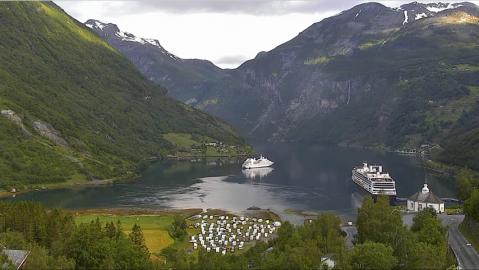Preikestolen or Prekestolen, also known by the English translations of Preacher's Pulpit or Pulpit Rock, is a famous tourist attraction in Forsand, Ryfylke, Norway. It consists of a steep cliff which rises 604 metres (1982 feet) above Lysefjorden, opposite the Kjerag plateau, with an almost flat top of approximately 25 by 25 metres (82 by 82 feet). Tourism at the site has been increasing in recent years, with between 150,000 and 200,000 visitors in 2012[1] making it one of the most visited natural tourist attractions in Norway. Due to its increased popularity, there is currently a project under way to improve the path to the site, which is only accessible via a 3.8 km (2.4 mi.) hike. Preikestolen is located in Ryfylke, Rogaland, a county in Western Norway. The city of Stavanger, the fourth largest in Norway, is located 25 kilometers from the site, and the parking facility for Preikestolen is located about one hour from Stavanger by ferry and car. Access to Preikestolen from Stavanger is via the RV13 road and the ferry from Tau. From the south, access is by the RV13 through Sandnes via the ferry from Lauvik to Oanes. The road is usually open and the ferries running year-round. However, due to snow, it is not always possible to do the hike to the top in the winter. The road to the site ends at a parking facility at Preikestolen Fjellstue, with a trail extending from the parking facility to the site. A round-trip hike to Preikestolen from the closest car park takes about 3–4 hours for someone of average fitness. The walk to Preikestolen is very steep in places. The path starts at the Preikestolhytta, at an elevation of approximately 270 metres (886 feet) above sea level, and climbs to 604 metres (1982 feet). The hike takes 1–3 hours depending on experience and fitness level. Even though the elevation differential is only 334 metres (1096 feet) and the walk is not particularly long (3.8 km each way), the total elevation gain and loss over the course of the hike is more than one might initially expect, as the path climbs and descends various ridges. The walk is not recommended in winter and spring when there is snow and ice, and the track may be slippery. The best season to hike the trail is from April to October. Sturdy shoes and rain gear are recommended for the hike. Check out more awesome videos at http://besttravelvideo.blogspot.com
- Category
- STAVANGER
Commenting disabled.





